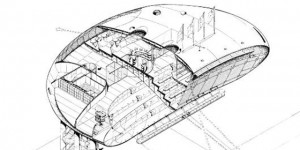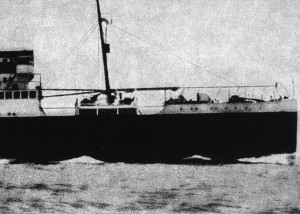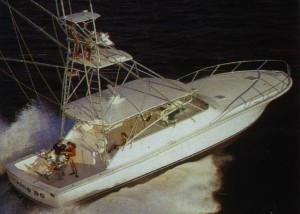|
 In late April 1999 Future System’s Lord’s Media Centre was officially introduced to the public. 14 years on I think it is about time to revisit Jan Kaplicky‘s probably most pivotal building (and the one he was said to like best). Its realisation is widely regarded as a major breakthrough in modern architecture, as it is considered to be the first building constructed according to principles normally common to ship building technologies. In late April 1999 Future System’s Lord’s Media Centre was officially introduced to the public. 14 years on I think it is about time to revisit Jan Kaplicky‘s probably most pivotal building (and the one he was said to like best). Its realisation is widely regarded as a major breakthrough in modern architecture, as it is considered to be the first building constructed according to principles normally common to ship building technologies.
I am not interested in questioning the building’s position as a piece of (absolutely undisputed) design qualities within the canon of modern architecture, but would rather like to critically evaluate, whether the attempted technology transfer from ship-building technology to building construction technology has yielded economically successful results.
I want to argue that the design and the realisation of the Lord’s Cricket Ground Media Centre were not the results of parametric processes or of contemporary digital design strategies, whose complex curvilinear results or large-scale arrangements necessitated the introduction of ship building technology, but in fact rather stem from pointed ideological positions, that I intend to trace back and exemplify along a series of deeply modernist trajectories throughout Jan Kaplicky’s education and architectural work.
So, if, as a consequence, the construction method chosen for the Media Centre is in fact an idealized one, rather than the ideal one, it seems worth investigating then, up to which extent ship building techniques could be incorporated into its construction process without losing the significant advantages, they are praised for.
The architectural practice of Future Systems has always been dedicated to the ideas of prefabrication and industrialization. Looking at the still lingering ideologies of modernism, the realisation of their concept devised for the Lord’s Media Centre, of having an entire building produced, assembled and completed by one single contractor, taken from the field of ship building industries, seems to be the fulfilment of the ultimate modernist dream.
 However, the idea of establishing close conceptual connections between architecture and large-scale industrially assembled products, like ships, aircrafts or automobiles, can be traced back to the beginning of the modernist movement. These comparisons were first dominated by aesthetic perception, as industrial objects seemed to be able to transfer a new, much desired machine-like aesthetics to architecture, capable of replacing the then prevailing traditional styles. This preliminary visual preoccupation is evident in Le Corbusier’s programmatic book ‘Towards A New Architecture’, in which the whole chapter ‘Eyes Which Do Not See’ (LC, 1982: 75) is dedicated to the description of the aesthetic qualities intrinsic to industrialized products. The adoption of industrial production techniques on the other hand, was envisioned to give way to a whole range of new powerful materials and technologies that would introduce “more technical beauty” (LC, 1982: 82) into architecture. However, the idea of establishing close conceptual connections between architecture and large-scale industrially assembled products, like ships, aircrafts or automobiles, can be traced back to the beginning of the modernist movement. These comparisons were first dominated by aesthetic perception, as industrial objects seemed to be able to transfer a new, much desired machine-like aesthetics to architecture, capable of replacing the then prevailing traditional styles. This preliminary visual preoccupation is evident in Le Corbusier’s programmatic book ‘Towards A New Architecture’, in which the whole chapter ‘Eyes Which Do Not See’ (LC, 1982: 75) is dedicated to the description of the aesthetic qualities intrinsic to industrialized products. The adoption of industrial production techniques on the other hand, was envisioned to give way to a whole range of new powerful materials and technologies that would introduce “more technical beauty” (LC, 1982: 82) into architecture.
At the same time another reoccurring theme of modernism, the issue of standardization and prefabrication became related to ship- and aircraft industries. Based on social considerations, the rationalisation of building production was supposed to solve the existing housing problems. The application of new automated production techniques and new materials like aluminium or plywood, should provide affordable industrialized products of high quality, ranging in size from furniture to entire housing schemes.
Ivan Margoliu s gives us a rather comprehensive account of Jan Kaplicky*s architectural and cultural education in his homage published in AD Vol.79 No.4 “Digital Cities”. As a small child he seemed to have been fascinated by the powerful imagery of “[...] military machinery of the times: tanks, armoured cars, weapons and aeroplanes [...]” (Margolius, 2009:101), and his parents’ house “[... ] was furnished with Bauhaus metal tube chairs, tables and sofas.” (Margoluis, 2009:103). Kaplicky travelled to Moscow and the US to “[visit] the national US exposition, where he saw Richard Buckminster Fuller’s houses, Charles Eames’ furniture and American automobiles.” Car technology turned out to be a re-ocurring theme, when later on after having set up his own practice, he became infatuated with the design and construction of a Czech car, which he even tried to borrow and park in his office. Margolius even claims that Kaplicky’s fascination of “[its] monocoque skin, a frameless structural shell construction […] developed into Future System’s central passion” (Margolius, 2009: 105). Consequently it should not come as a surprise, that the trajectories of most modernist ideological positions could always be found in the architecture of Future Systems. s gives us a rather comprehensive account of Jan Kaplicky*s architectural and cultural education in his homage published in AD Vol.79 No.4 “Digital Cities”. As a small child he seemed to have been fascinated by the powerful imagery of “[...] military machinery of the times: tanks, armoured cars, weapons and aeroplanes [...]” (Margolius, 2009:101), and his parents’ house “[... ] was furnished with Bauhaus metal tube chairs, tables and sofas.” (Margoluis, 2009:103). Kaplicky travelled to Moscow and the US to “[visit] the national US exposition, where he saw Richard Buckminster Fuller’s houses, Charles Eames’ furniture and American automobiles.” Car technology turned out to be a re-ocurring theme, when later on after having set up his own practice, he became infatuated with the design and construction of a Czech car, which he even tried to borrow and park in his office. Margolius even claims that Kaplicky’s fascination of “[its] monocoque skin, a frameless structural shell construction […] developed into Future System’s central passion” (Margolius, 2009: 105). Consequently it should not come as a surprise, that the trajectories of most modernist ideological positions could always be found in the architecture of Future Systems.
The range of objects presented as sources of inspiration to Future Systems in their publication of 2001 bears more than a strong resemblance to those Le Corbusier referred to in his 1922 publication. Nine out of seventeen images depict ships or aircrafts (Future Systems, 2001:14). The concept of using ship building technologies to solve current social problems is most strikingly visible in Future System’s 1990 ‘Boatel’ project, providing “a temporary accommodation for 150 homeless people on the Thames in London.” (Field, 1999: 36). Comparing the claim of Jean Prouvée, that “[…] if aeroplanes were put into production in the manner of buildings they would not fly.” (Huber, 1972: 23) and Jan Kaplicky’s statement “I am glad the jumbo jet was not designed by an architect – if it had been, it would never have flown.” (Field, 1999: 33) indicates, that both of them share the same ideological position.
“[…] convinced, that the architecture of straight lines is history.” (Field, 1999: 33), Kaplicky had always been investigating into buildings that encompass spatial complexity and go beyond the traditional orthogonal conception of space, which still prevails in modernism. An examination of Future Systems’ works and projects shows, that their design process has always been driven by the urge to move from the classical eight-cornered understanding of space to more curvaceous propositions. The fact, that such shapes are more familiar in aircrafts and boats, explains Future Systems early preoccupation with the manufacturing technologies of the aircraft and ship building industry.
The fabrication techniques used in shipbuilding and in related industries have proven highly successful in their own domain, and have, since their introduction to architecture by modernism, always been related to building construction by architects, who were referring to a number of advantages they appeared to have. Until the realisation of the Lords Media Centre nevertheless they had only been thoroughly applied in their own fields of construction. The realisation of an artefact, whose fabrication and construction process, for the first time, was largely informed by this set of technologies inevitably leads to the question, up to which extent construction methods can be transferred from their intrinsic environment to an architectural environment, where entirely different rules and parameters apply.
Ship and aircraft building technologies have been developed over the years to optimise a ship’s or an aircraft’s performance as means of transportation in a liquid or aerial environment. Consequently ships and planes are always planned and constructed in respect to the latest related techniques. Driven, as indicated above, by aesthetic and ideological intentions, the shapes that Future Systems assign to their buildings, on the other hand, reach a point of spatial complexity that suggest the introduction of ship building technologies into building construction.
Consequently basic rules and implications of ship building technology no longer influence the act of form finding, but production techniques have to be adapted in order to be applied to a previously designed arbitrary shape. This reversal of the normal construction concept affects the manufacturing process considerably and leads, as is going to be explained in the second part of this text, at certain points to situations, where the advantages of ship building methods start losing their significance.
Part 2 will investigate into the contextual parameters, that link or distinguish the fabrication of large vessel from the construction of a building like the Media Centre and analyse, if a given conception of a curvaceous architectural spatial organisation can subsequently be constructed by means of ship construction methods.
Bibliography:
Field, Marcus. Future Systems. London:Phaidon Press Ltd., 1999. ISBN 0-7148-3381-4.
Future Systems. Unique Building. Lord’s Media Centre. Chichester: John Wiley & Sons, 2001. ISBN 0-471-98512-0.
Huber, Benedikt et al. Jean Prouvé. Prefabrication: Structure and Elements. London: Pall Mall Press, 1971. ISBN 3-907044-93-2.
Le Corbusier. Ausblick auf eine Architektur. Braunschweig: Vieweg & Sohn Verlag, 1982. ISBN 3-528-18602-X.
Margolius, Ivan. Jan Kaplicky. In AD Vol. 79, No. 4 (July/August 2009) Digital Cities. ISSN 0003-8504.
Tags: future systems, innovative design and construction technologies, lord's media centre, modernism, prefab, research, shell structures, shells, shipbuilding, technology transfer, writings
|